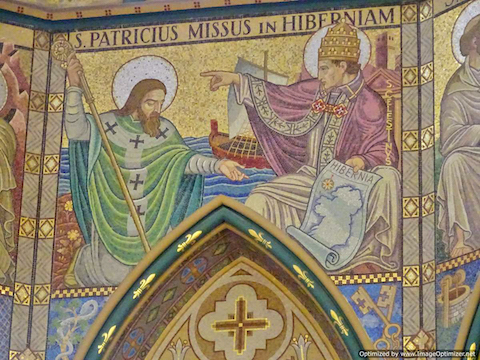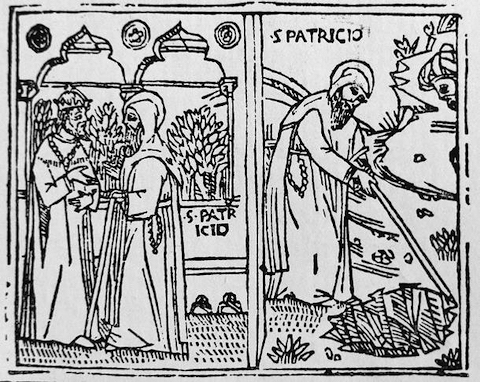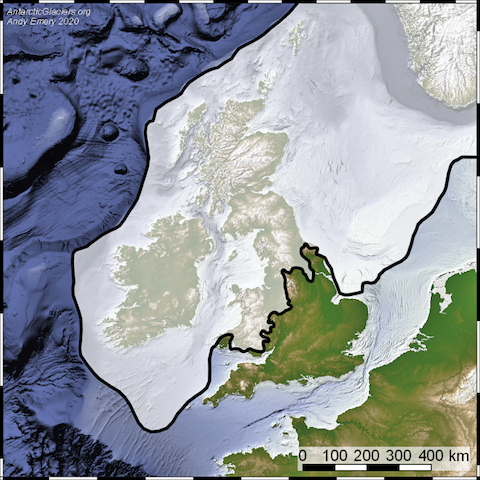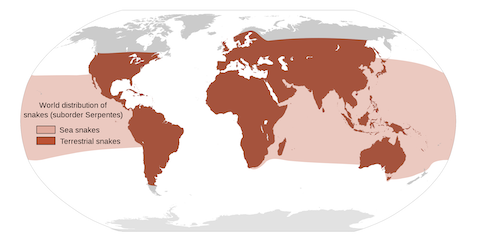
There are no snakes in Ireland. Because, according to legend, St. Patrick expelled them. True, or folk tale?
St. Patrick, ironically, wasn’t Irish. Or, named Patrick. He was born Maewyn Succat in 390 AD in Britain, kidnapped by pirates at 16, and held in slavery in Ireland for 6 years.
He escaped and joined a monastery in England. Then decided to return to Ireland as a missionary, where he converted Druids and built the first church.
He died in 460 AD in Downpatrick, hence the name. A few centuries later, he was recognized as Ireland’s patron saint for bringing Christianity to the land.
A few centuries after that, his mythology had grown. Apparently, the snakes of Ireland once threatened him on a hilltop. He responded by beating a drum that drove them into the sea.
Scholars believe this is a symbolic tale of Patrick purging Ireland of its pagan rituals.
Scientists argue that Ireland never had snakes in the first place.
In the last Ice Age, Ireland was covered in glaciers, much too cold for the cold-blooded creatures. Since the ice retreated, Ireland has been isolated by the frigid Irish sea.
There are other isolated islands, like New Zealand and Hawaii, that don’t have snakes. And other cold regions, like Alaska and Northern Russia. So, it’s not as unusual as it sounds.
But it makes for a good story over a green beer.
Background
Synopsis: St. Patrick’s Day marks the anniversary of death of the patron saint of Ireland in the fifth-century AD. Among other amazing feats, folklore says that St. Patrick drove all of Ireland’s snakes into the sea. Ireland is snake free today, but what is the real story behind the legend?
- The Feast of St. Patrick is a holiday celebrated by Irish communities around the world.
- The 17th of March is the anniversary of Saint Patrick’s death in AD 460.
- Since 1776, New York City has held annual parades with recent events drawing more than 300,000 marchers and 2 million spectators.
- Boston’s parades began in 1737, including beer dyed green to celebrate the “Emerald Isle.”
- In 1962, Chicago started dying its river green to honor the day.
- Many other global cities celebrate the day with parades, including Moscow since 1992.
- Ironically, Saint Patrick wasn’t Irish.
- Maewyn Succat was born in England, Wales or Scotland in about AD 390.
- When he was about 16 years old he was captured by pirates, sold as a slave, and kept in bondage in Ireland for 6 years.
- After he escaped he became a monk and progressed through the ranks of the Catholic Church.
- He returned to Ireland as a missionary in AD 433 and began converting Druids to Christianity, building the first Irish church at Saul, Ireland. He incorporated traditional rituals into teachings about Christianity to engage local pagans.
- He is recognized as the founder of Christianity in Ireland and by the seventh-century AD was widely popularly recognized as the patron saint of Ireland.
- He was never formally canonized but is regarded as a Saint by the Catholic, Eastern Orthodox, Anglican and Lutheran churches.
- He died in AD 460 and was buried in Downpatrick, Ireland, which became the basis of his Irish sounding moniker.

One of the many legends surrounding the life of Saint Patrick tells of his visions of purgatory. Credit: Unknown author, via Wikimedia Commons
- Irish culture is rich with oral legends and myths, and many stories about Saint Patrick have resulted from hundreds of years of increasingly exaggerated folk tales.
- Ireland has no snakes, so one of the most popular legends describes how Saint Patrick eradicated Ireland’s snakes.
- In a seventeenth-century summary of Ireland’s religious history, the priest John Colgan tells the story of Saint Patrick beating a drum to lure snakes to the sea after they threatened him on a hill. When the drum tore, an angel came to repair it. Afterward Saint Patrick rendered Irish soil toxic to serpents.
- Scholars believe that the story is an allegory for ridding the island of ancient pagan beliefs.
- Scientists suggest a different reason that Ireland is serpent free—glaciation.
- During the last Pleistocene glaciation, Ireland was covered by continental ice sheets, making it too chilly for the cold-blooded serpents that rely on their environments to control their body temperatures.

An ice sheet covered Ireland during the Last Glacial Maximum around 20,000 years ago. Credit: AntarcticGlaciers.org, https://creativecommons.org/licenses/by-nc-sa/3.0/deed.en_GB. - Wide bodies of water, including the frigid, inhospitable Irish Sea, have surrounded Ireland since the last land bridge connecting it to Great Britain foundered around 8,500 years ago.
- Although snakes have lived on Earth for more than 100 million years, no snake fossils have ever been found in Ireland. So there never were any snakes in Ireland that Saint Patrick could banish.
- In the 1960s, a legless lizard called the slow worm (Anguis fragilis) that resembles a snake was introduced to Western Ireland’s County Clare, but these reptiles appear to be staying within localized habitats in the limestone terrain.
- During the last Pleistocene glaciation, Ireland was covered by continental ice sheets, making it too chilly for the cold-blooded serpents that rely on their environments to control their body temperatures.
- Ireland is one of a few snake-free places on Earth, all of which are characterized by being too geographically isolated or too cold to provide livable habitats for snakes.

World distribution of terrestrial and sea snakes. Credit: Eightofnine, via Wikimedia Commons - Other geographically isolated snakeless places include New Zealand, Hawaii and a few small islands in the Atlantic and Pacific.
- Once snakes reach the boundary of tundra, their body fluids begin to freeze. Cold serpent-free places include arctic regions like Alaska, Greenland, and the northern reaches of Russia, Norway, Sweden, Finland, and Canada, as well as Antarctica and the southernmost tip of South America.
- In serpent-free countries, governments work hard to protect their native ecosystems from these predators in the event they escape and start breeding in the wild.
- Snakes have been introduced to islands accidentally with dire results. During World War II, brown snakes hitchhiking on supply ships were introduced to Guam with devastating impact on local birds, which also adversely affected trees and plants that depended on the birds to disseminate their seeds.
- In other serpent-free places like Hawaii, it is a felony with a fine of up to $200,000 plus up to three years in prison for possession or transportation of a snake into the state.
- In New Zealand, snake handlers around the country find and catch any snakes that try to slither into the country, and zoos are prohibited from having snakes.
- Although some countries banish snakes today, the fables about the mythical snake charming powers of Saint Patrick turn out to be symbolic folklore.

